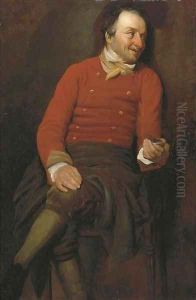Julius Henricus Quinkhard Paintings
Julius Henricus Quinkhard was a Dutch painter born in Rees (near Cleves), Germany, in 1688. He moved to the Netherlands, where he became an influential figure in the Dutch art scene of the 18th century. Quinkhard is primarily known for his portraits, which were highly sought after by the Dutch elite, as well as his genre scenes that often depicted everyday life with a keen eye for detail and emotion.
Quinkhard's training and early career are notably marked by his apprenticeship with Arnold Boonen in Amsterdam, a well-regarded portrait painter of his time. This tutelage played a significant role in shaping Quinkhard's artistic style, which blended the elegance of the late Baroque with the emerging sensibilities of the Rococo period. His ability to capture the likeness and character of his sitters, along with his sophisticated use of light and shadow, garnered him a distinguished reputation.
Throughout his career, Quinkhard's clientele included members of the Dutch bourgeoisie, scholars, and politicians, which was a testament to his skill and popularity. Besides portraits, he also engaged in creating historical paintings and was involved in various artistic societies, further establishing his status within the Dutch art community.
Quinkhard's contribution to the Dutch art of the 18th century is also marked by his role as a teacher, passing on his techniques and aesthetic values to the next generation of artists. He died in Amsterdam in 1772, leaving behind a legacy that was appreciated for its portrayal of the human condition, as well as its elegance and refinement. His works continue to be studied and admired for their historical significance and artistic merit, offering insights into the cultural and societal nuances of his time.
